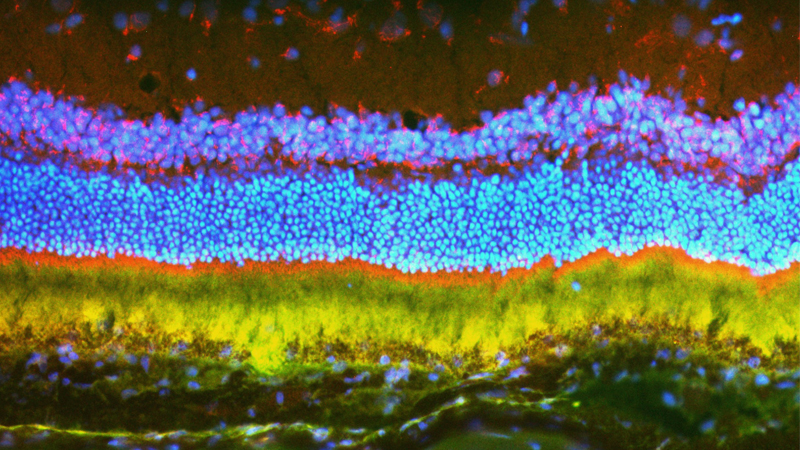Jul 8 2020
Two researchers from Johns Hopkins University—an ophthalmologist and an engineer—have successfully used nanoparticles to deliver gene therapy for blinding eye disease. They achieved this by performing experiments in mice and rats.

Image Credit: Johns Hopkins Medicine.
Using an exclusively designed large molecule, the researchers could compact huge bundles of therapeutic DNA to be delivered into the cells of the eye.
Reported in the Science Advances journal on July 3rd, 2020, the study offers evidence of the prospective value of nanoparticle-delivered gene therapy for the treatment of wet age-related macular degeneration.
Macular degeneration is an eye disease in which blood vessel growth is abnormal, causing damage to the light-sensitive tissue at the back of the eye, together with rarer, inherited blinding diseases of the retina.
Several gene therapy techniques rely on viral vectors, which tap the natural ability of a virus to carry genetic material into cells. But viruses tend to create an immune response that prevents repeat dosing, and the one most often used for ocular gene therapy is not capable of carrying large genes.
Some of the most prevalent inherited retinal degenerations are due to mutations in large genes that simply cannot fit into the most commonly used viral vector.
Peter Campochiaro, MD, Eccles Professor of Ophthalmology, Johns Hopkins University School of Medicine
Campochiaro is also a member of the Johns Hopkins Medicine Wilmer Eye Institute.
Campochiaro and Jordan Green, PhD, created a new technique to overcome such drawbacks, which involves using a biodegradable polymer that surrounds and compacts long DNA stretches. This helps create nanoparticles with the potential to enter the cells. This technology enables the conversion of the cells of the eye into mini factories for a therapeutic protein.
The researchers first tested whether the nanoparticles enter their target cells by loading the nanoparticles with a gene for a fluorescent protein that makes cells glow similar to a glow stick.
Using the glowing molecule, the researchers were able to find the location, duration, and amount of gene expression that can be achieved using the nanoparticles.
Even eight months following treatment, it was found that most of the light-sensitive cells in the eyes of the rats glowed, demonstrating that the nanoparticles effectively loaded the fluorescent gene into the cells.
A similar experiment was also performed using the nanoparticles to shuttle a biologically relevant gene into the eye. A gene for vascular endothelial growth factor (VEGF) was loaded into the nanoparticles, where the gene takes part in the growth of abnormal blood vessels in people suffering from wet macular degeneration.
The eyes of 30 rats were injected with the nanoparticles that carried the VEGF gene, and the effects in the retina were determined one, two, and five months post-injection. One month post-injection, abnormal blood vessels developed in each tested rat under and inside the retina, similar to those seen in patients suffering from wet macular degeneration.
The abnormal blood vessels were found to be more widespread at two and five months post-injection, and there was related scarring under the retina such as those observed in chronic untreated wet macular degeneration.
These results show that the genes delivered by nanoparticles stayed active within the cells for several months.
Peter Campochiaro, MD, Eccles Professor of Ophthalmology, School of Medicine, Johns Hopkins University
Lastly, the researchers tested the ability of a nanoparticle to deliver a therapeutic gene for the disease by using mice that had been genetically engineered to develop a kind of wet macular degeneration such as those seen in humans. Nanoparticles were loaded with a gene that synthesizes a protein that neutralizes VEGF.
At present, such proteins that block VEGF proteins are injected by physicians into the eyes of people suffering from macular degeneration. This treatment helps control the overgrowth of abnormal, leaky blood vessels. However, this process must be repeated often and is cumbersome for patients and their caretakers.
Three weeks post-injection of nanoparticles with the gene for the anti-VEGF protein, a 60% decrease in abnormal blood vessels was observed in the mice.
The same effect was observed 35 days later.
These results are extremely promising. We have the ability to reach the cells most significantly affected by degenerative eye disease with nonviral treatments that can allow the eye to create its own sustained therapies.
Jordan Green, PhD, Professor of Biomedical Engineering, School of Medicine, Johns Hopkins University
In the United States, approximately 1.6 million people suffering from macular degeneration are administered injected drugs to the eye every four to six weeks. A gene therapy treatment could offer a means for the tissue of the eye to prevent further deterioration of vision with only a few initial treatments.
Genetic diseases that lead to blindness could be similarly treated by introducing functional versions of genes disabled by inherited mutations.
Jikui Shen, Jayoung Kim, Stephany Tzeng, Kun Ding, Zibran Hafiz, Da Long, and Jiangxia Wang from the Johns Hopkins University School of Medicine are the other researchers involved in this study.
This study was financially supported by the National Eye Institute (01EY031097, R21EY026148, R01EY028996, EY01765), the National Institute of Biomedical Imaging and Bioengineering (R01EB022148) Research to Prevent Blindness (the Dr H. James and Carole Free Catalyst Award and an unrestricted grant), the Louis B. Thalheimer Fund for Translational Research; the Barth Syndrome Foundation, Samsung, Conrad and Lois Aschenbach, Per Bang-Jensen, Andrew and Yvette Marriott, and Jean Lake.
Journal Reference:
Shen, J., et al. (2020) Suprachoroidal gene transfer with nonviral nanoparticles. Science Advances. doi.org/10.1126/sciadv.aba1606.